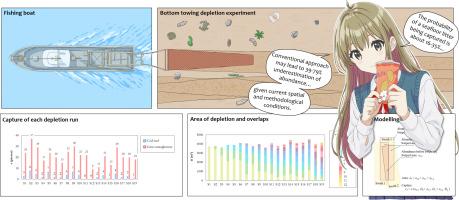Estimating gear efficiency of toothed fishing dredge for collecting seafloor litter
IF 4.9
3区 环境科学与生态学
Q1 ENVIRONMENTAL SCIENCES
引用次数: 0
Abstract
In this study, depletion experiments using a toothed fishing dredge were conducted to estimate the gear efficiency for collecting seafloor litter in a nearshore area on the north side of Tokyo Bay. Using the catch data of cod-end samples and gear-entangled samples, four models (Leslie-Davis model, DeLury model, normal patch model, and negative binomial patch model) were applied to fit the dataset. Analysis of the collected seafloor litter showed that plastics were the dominant category, accounting for 61.8–90.0 % by count (depending on whether the sample was from the cod-end or gear entanglement), with polyethylene (PE) as the predominant polymer type (50.5 %). Cross-validation identified the normal patch model as the most appropriate model for inference, yielding a gear efficiency estimate of 34.8 % and a corresponding seafloor litter abundance of 4000 pieces/km2 based on cod-end samples. Compared to conventional methods that assume 100 % gear efficiency, this suggests that seafloor litter abundance is underestimated by 38.6 % and 79.4 % given current experimental conditions. When all litter samples were included, i.e., both cod-end samples and gear-entangled samples, the estimated gear efficiency was 18.7 %, with a corresponding seafloor litter abundance of 45,200 pieces/km2. This suggests that excluding gear-entangled litter, mainly plastic sheet fragments from bags, can result in underestimation by as much as 91 %. These findings highlight the importance of accounting for gear efficiency and incorporating all gear-collected litter in bottom-towed surveys to more accurately assess seafloor litter pollution.

齿形捕鱼挖泥船收集海底垃圾的齿轮效率估算
在本研究中,使用齿形捕鱼挖泥船进行了枯竭实验,以估计东京湾北侧近岸地区收集海底垃圾的齿轮效率。利用鱼尾样本和齿轮纠缠样本的渔获数据,采用Leslie-Davis模型、DeLury模型、正态补丁模型和负二项补丁模型对数据集进行拟合。对收集到的海底垃圾的分析表明,塑料是主要的类别,占61.8 - 90.0%(取决于样本是来自鱼尾还是渔具缠结),聚乙烯(PE)是主要的聚合物类型(50.5%)。交叉验证表明,正常斑块模型是最合适的推断模型,得出的齿轮效率估计为34.8%,对应的海底凋落物丰度为4000片/km2。与假设齿轮效率为100%的传统方法相比,这表明在当前实验条件下,海底凋落物丰度被低估了38.6%和79.4%。当包括所有凋落物样本时,即cod端样本和齿轮纠缠样本,估计齿轮效率为18.7%,相应的海底凋落物丰度为45,200件/km2。这表明,如果不包括装备缠绕的垃圾,主要是塑料袋上的塑料片碎片,可能会导致高达91%的低估。这些发现强调了在海底拖曳调查中考虑齿轮效率和将所有齿轮收集的垃圾纳入调查的重要性,以更准确地评估海底垃圾污染。
本文章由计算机程序翻译,如有差异,请以英文原文为准。
求助全文
约1分钟内获得全文
求助全文
来源期刊

Marine pollution bulletin
环境科学-海洋与淡水生物学
CiteScore
10.20
自引率
15.50%
发文量
1077
审稿时长
68 days
期刊介绍:
Marine Pollution Bulletin is concerned with the rational use of maritime and marine resources in estuaries, the seas and oceans, as well as with documenting marine pollution and introducing new forms of measurement and analysis. A wide range of topics are discussed as news, comment, reviews and research reports, not only on effluent disposal and pollution control, but also on the management, economic aspects and protection of the marine environment in general.
 求助内容:
求助内容: 应助结果提醒方式:
应助结果提醒方式:


